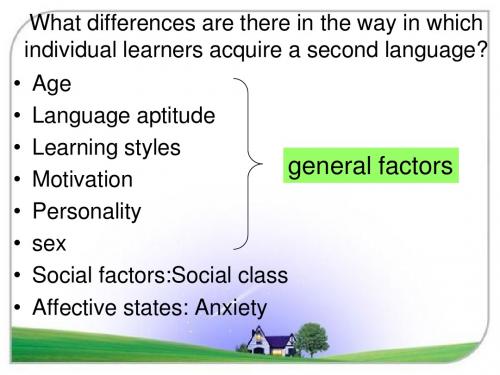二语习得PPT 5.5learningmotivation
- 格式:ppt
- 大小:190.00 KB
- 文档页数:16

二语习得PPT整理二语习得一.二语习得概述(一)语言习得研究中的两个基本问题(1)逻辑问题(logical problem):语言习得是如何成为可能的?一个很有吸引力的推测是,儿童学会母语,是因为生活在母语环境中,每天接触母语所致。
但是,阿猫阿狗也接触人类语言,但没有一只猫、狗能学会人类语言。
这至少说明:A.接触语言是语言习得的必要条件,但并不是充分条件;B.在语言习得方面,人类似乎天生有一种其他动物没有的潜能。
There is a mismatch between the input (the utterance that the child is exposed to) and the output (the unconscious grammatical knowledge that the child acquires). This mismatch gives rise to what is known as the problem of the poverty of the stimulus(刺激贫乏)or the logical problem of language acquisition(语言习得逻辑问题). Given such underdetermination, the claim is that it would be impossible to acco unt for the L1 acquirers’ achievement without postulating a built-in system of universal linguistic principles and grammatical properties.(在语言习得方面,人类似乎天生有一种其他动物没有的潜能)(2)发展问题( developmental problem ):语言习得遵循一定的发展顺序和步骤。





Gardner classifies motivation into two parts:integrative orientation and instrumental orientation.Integrative orientation is a" motivation to learn a second language because of positive feelings toward the community that speaks that language" (Gardner,1985, p. 82-3).It indicates an interest in learning the language in order to meet and communicate with members of the second language community. Integrative motivation is a composite construct made up of three main components: integrativeness, attitudes towards the learning situation, and motivation (as isshown in Table 1).Table 1 Gardner's conceptualisationof the integrative motivationFromD rnyei, 2005, p. 50From Gardner's view point, integrativeness reflects a genuine interest in learning the second language in order to come closer psychologically to the other language community. It contains elements such as integrative orientation, interest in foreign languages, and attitudes towards the L2 community. Integrativeness involves emotional recognition of another cultural group. It helps to create a favorable attitude toward the language community.In Gardner's motivational model, attitudes toward the learning situation include the learner 'se valuation of the L2 teacher and evaluation of theL2 course. Gardner (2004) further explains that attitudes toward the learning situation involve attitudes toward any aspect of the situation in which the language is learne d. In the context of school, these attitudes could be directed towards the teacher, the course in general, one's classmates, the course materials, extra-curricular activities associated with the course, etc. In any situation, some individuals will express more positive attitudes than others, and it is these differences in attitudes toward the learning situation that are the focus of the model.Motivation refers to the driving fo ce in any situation. In the socio-educational model, motivation to learn a second language is viewed as three elements: desire to learn the L2, motivational intensity(effort), and attitudes towards learning the L2.First, the motivated individual wants to achieve the goal. Such an individual will express a desire to succeed, and will strive to achieve that success. Second, the motivated individual expends effort to learn the language. There is a persistent and consistent attempt to learn the material: by doing homework, by seeking out opportunities to learn more, by doing extra work, etc. Third, the motivated individual will enjoy the task of learning the language. Such an individual will say that it is fun, a challenge, and enjoy-able, although the level of enthusiasm may vary at different times.In the socio-educational model, all three elements, desire, effort, andpositive affect, are seen as necessary to distinguish between individuals who are more motivated and those who are less motivated. Each element, by itself, is seen as insufficient to explain motivation.Some students may display effort, even though they have no strong desire to succeed, and may not find the experience particularly enjoyable. Others may want to learn the language, but may have other things that reduce their effort. The truly motivated individual displays effort, desire and affect. These three variables, Integrativeness, Attitudes toward the Learning Situation, and Motivation, form Integrative Motivation.Unlike integrative motivation,instrumental orientation stresses the pragmatic aspects of learning a second language, without any particular interest in communicating with the second language community (Gardner, Smythe, and Brunet 1977, p. 244, cited from Spolsky, 2003). With instrumental motivation the purpose of language acquisition is utilitarian, such as meeting the requirements for school or university graduation, applying for a job, or qualifying for higher pay.Both integrative and instrumental motivationsare essential to successful learning. But integrative motivation has been found to sustain long-term success when learning a second language (Taylor, Meynard and Rheault 1977; Ellis 1997; Crookes et al1991, cited in Norris-hot, 2001). That is, the students who are most successful when learning a target language are those who like the people that speak the language, admire the culture, and have a desire to become familiar with or even integrate in to the society in which the language isused (Falk,1978,cited in Norris-hot, 2001).In their early research, Gardner and Lambert viewed integrative motivation as more important in a formal learning environment than instrumental motivation (Ellis 1997, cited in Norris-hot, 2001). In later studies, integrative motivation has continued to be emphasized, although now the importance of instrumental motivation is also stressed. It is important to note that instrumental motivation has only been admitted as a significant factor in some research, whereas integrative motivation is continually linked to successful second language acquisition. However, it has been found that students generally select instrumental reasons more frequently than integrative reasons for the study of language. Students who have integrative motivation, however, are usually more highly motivated and more successful in their language learning.Other research has validated Gardner's theory.Some studies have found that instrumental motivation and other types of motivation affect L2 linguistic achievement ( Laine, 1981; Gardner and MacIntyre,1991; D rnyei, 1990; Lambert et al., 1968; Burstall,1975; Gardner, 1996,cited in Manfred Wu Man-Fat, 2005). One area where instrumental motivation proves vital is when the learner is provided with no opportunity to use the target language and therefore, has no chance to interact with members of the target language group.Lukmani (1972, cited in Norris-hot, 2001) found that an instrumental orientation was more important than an integrative orientation in non-westernized female learners of L2 English in Bombay.Yet some studies have failed to find any relationship between integrative motivation and L2 linguistic achievement (Oller, Baca and Vigil, 1977;Oller and Perkins, 1978; Chihara and Oller, 1978,ci-ted inManfredWuMan-Fat,2005).Some researchers believe that social situation helps to determine both what kind of orientation a learner might have and which motivation is more important for language learning. Learner success may be the result of the mixture of both types of motivations. (Jacqueline Norris-Holt, 2000).Though debates are still going on, Gardner's model has dominated the field of language learning motivation since its introduction, and much evidence has confirmed the strong correlation betweenintegrative motivation and L2 linguistic achievement (seeEl-lis,1999;Laine,1981;Kraemer,1990,citedinGard-ner and MacIntyre, 1992; Skehan, 1989; Oxford and Ehrman, 1993; Spolsky, 1989, cited in Manfred Wu Man-Fat, 2005).⏹[1] Gardner.R.C.and W. E. Lambert. Motivational variables inSecond language Acquisition [J]. Canadian Journal of Psychology,1959,13:266-72.⏹[2] Gardner, R.C. (1985). The Attitude/Motivation Test Battery:Technical Report (1985) Retrieved January 5,2006⏹[3] Gardner R C. Social Psychology and Language Learning: TheRole of Attitude and Motivation[M]. London: Edward Arnold, 1985⏹[4] Noels.K.A.R Clement & L. G. Pelletier. Perceptions ofteachers‘ communicative style and students’ intrinsic and extrinsic motivation. Modern Language Journal,1999,83:23-34⏹[5] Ryan, R. M., & Deci, E. L. On Intrinsic and ExtrinsicMotivations: Classic Definitions and New Directions [J].Contemporary Educational Psychology, 2000: 25, 54-67.⏹[6] 杜正学.浅谈加德纳的动机模式[J].陇东学院学报,2008:1,19.⏹[7] 秦晓晴.动机理论研究及其对外语学习的意义[J].外语研究,2002,74(4): 75.⏹[8] 王月芳.外语学习动机和学习策略的研究及其对大学英语教学的启示[J].江苏理工大学学报(社会科学版),1999,4: 81.⏹[9] 徐传慧.近十年国内英语学习动机理论与实践研究综述———基于 5 种外语类核心期刊10 年(2001-2010)的统计分析[J].赤峰学院学报,2011:9,32⏹[10] 杨政红,丽华,志敏. Gardner的学习动机模式及大学英语课堂激发策略新探[J].宁夏大学学报,2010:1,32。